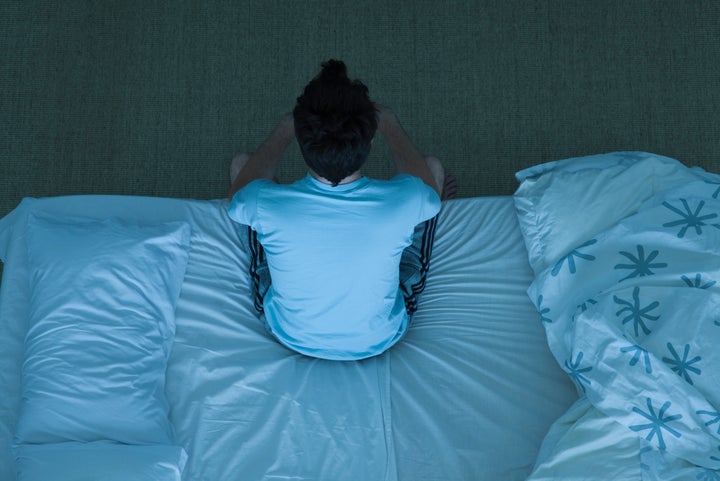
There’s nothing worse than being wide awake at 4 a.m., staring at the ceiling and willing yourself back to dreamland. Middle-of-the-night wake-ups can happen for many reasons, making it hard and frustrating to combat in the moment.
How about we break the cycle tonight? We’ve partnered with Sleep Number to bring you six scientifically proven tips and tricks that will have you back to sleep in no time.
1. Try Acupressure
Acupressure is an ancient therapy that involves finger placement and pressure over specific points on the body. These points follow the same channels, called meridians, used in acupuncture. Putting pressure (or needles) on these points is believed to promote blood flow and unlock tension ― among other benefits like alleviating lower-back pain and headaches.
Leigh Gilkey and Siri Michel, licensed acupuncturists and founders of Essential Acupuncture in Chicago, say that self-administered acupressure before bed can promote a restful night of uninterrupted sleep and, in the event of an unwanted nighttime awakening, can help get you back to sleep. A couple of their favorite points to treat insomnia include:
- Anmian, located behind the ear. Behind the ear is a bone called the mastoid process. Place your finger on the mastoid process and slide back off the bone and slightly upwards. Look for a little depression and press in a downward motion.
- Liver 3, located on the top of the foot. Place a finger between the first toe and the second toe and push toward your ankle. There is a depression before the junction of the first and second metatarsal bones. Simply pressing on it or pulling in a downward motion is great for activating this point.
2. Dunk Your Head In Ice-Cold Water
Yes, you read that right. Submerge your face into a bowl of ice water; making sure the area below your eyes and above your cheekbones is wet. Hold your breath for 30 seconds before coming back up for air. This will trigger your mammalian diving reflex, an involuntary human response that will automatically slow down your heart rate and encourage your body to calm itself by activating the parasympathetic nervous system. You will be left feeling relaxed and, you guessed it, more ready for sleep.
3. Reach That Big O
The reason most of us sleep soundly after sex is because oxytocin, the “love hormone,” counteracts stress hormones that can keep you wide awake. Likewise, the endorphins released during sexual activity ― be it solo or among partners ― are like nature’s sedative, working in tandem to help you fall asleep and stay asleep.
4. Grab A Snack
That anxious awakening you get in the middle of the night could be the result of low blood sugar, studies show. The adrenal glands, two walnut-shaped organs that sit atop the kidneys, play a key role in regulating blood sugar, especially as you sleep. When your blood sugar drops significantly through the night, these grands release stress hormones that trigger the body to raise blood sugar levels, and stress hormones are no friend to your beauty sleep.
While midnight snacks might not be great for your waistline, there are healthy food options to help you fall back asleep, says Michael Breus, a clinical psychologist and sleep specialist. He suggests eating a 250-calorie snack made up of 75 percent carbs, 25 percent protein. Things like an apple with nut butter, a small bowl of non-sugar cereal or frozen Greek yogurt are good options, he says.
5. Dim Those Lights
The next time you wake in the middle of the night and head to the kitchen for a midnight snack or a glass of water, try keeping those lights as dim as possible. It’s the same science that proves blue light exposure from cell phones has a bigger impact on decreasing melatonin levels than other light wavelengths.
“Nighttime light exposure ... suppresses the hormone melatonin, which plays an important role in regulating sleep and circadian rhythms,” Breus says in a blog post on his website.
Though unscientific anecdotes such as living by candlelight can purportedly be better for quality sleep and mindful living, there are safer options. Instead of turning on a light the next time you head to the bathroom in the middle of the night, try instead using a dimmer or another softer light source. You can also buy commercial products that will help limit exposure, like the bulbs from Lighting Science. “These will filter out blue light but still give a nice overall lighting solution,” Breus says.
6. Keep It Cool
Falling back asleep may be as simple as lowering the thermostat. Your core body temperature drops at the onset of sleep, which means that a too-warm (or too-cool) room may wake you up. The National Sleep Foundation suggests keeping the bedroom temp around 60 to 68 degrees to get you back to sleep. It’s the ideal temperature scale to layer on those PJs, blankets and duvet cover.
If you start to feel slightly overheated during the night, try stick one or both feet out from under the covers. Because we’re mammals, the palms of our hands and feet help regulate our core body temperature. Think of them as nature’s thermostats.
Just like diet and exercise, sleep is unique to each person and important for optimal health. Sleep Number® beds adjust on each side to your ideal level of firmness, comfort and support — your Sleep Number® setting. And when you add SleepIQ® technology, you’ll know what to adjust for your best possible sleep.